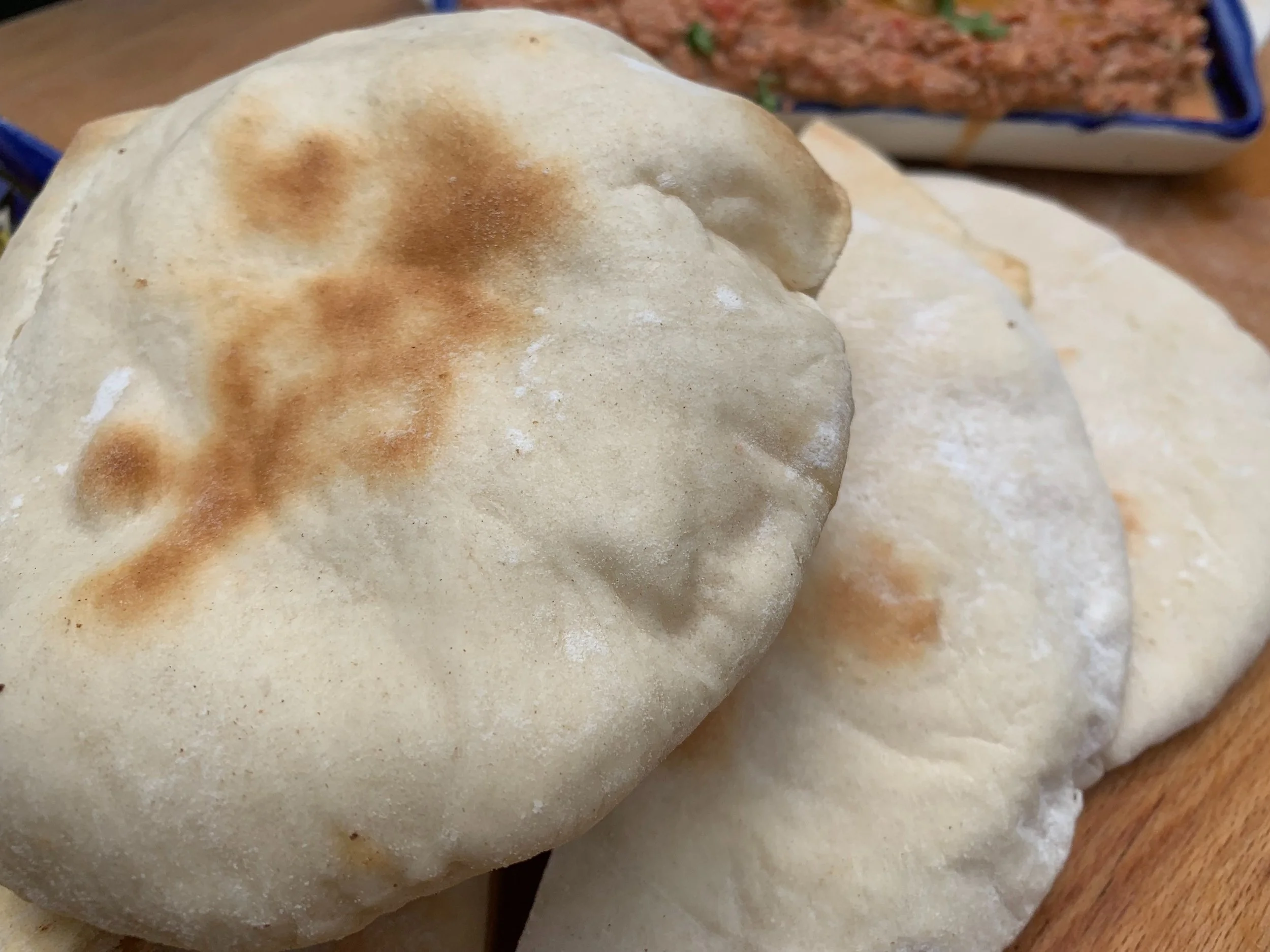Perfect Pita
Perfectly easy, with a perfect puffy pocket, in most every pita!
Perfect PIta (Khoubiz, Arab Pocket Bread)
1 tablespoon active dry yeast
3 teaspoons sugar
2 1/2 - 3 cups all-purpose flour
2 teaspoons salt
3 tablespoons tbsp extra virgin olive oil
-Pour 1 cup lukewarm water into a large mixing bowl and stir in yeast and sugar until dissolved. Add 1/2 cup flour and whisk lightly together. Place the bowl in a warm spot for 10 - 15 minutes or until the yeast mixture has a few bubbles on top.
-Add the olive oil, salt and most of the remaining flour and stir until the mixture forms a shaggy mass. Or if using an electric mixer with a dough hook, knead on low until the mixture leaves the sides of the bowl and balls around the dough hook to create a smooth mixture. If dough is too sticky, gradually add more flour, about 1/4 cup at a time, until the dough comes together in a ball. This should take about 5 minutes.
-If kneading by hand continue by dusting a counter with a little flour, dump the shaggy dough out onto the counter. Knead lightly for a couple of minutes or until smooth. Cover and let the dough rest for 10 minutes, then knead again for a couple more minutes. If the dough is too sticky add a bit of flour and continue to knead it into the dough until you have a smooth ball of dough.
-Clean the mixing bowl and dry it. Then coat it lightly with extra virgin olive oil and place the dough back in the bowl. Turn the dough a couple of times in the bowl to coat with the olive oil. Cover the mixing bowl tightly with plastic wrap and place in a warm spot. Let rise for an hour or until the dough increases to double in size.
-Deflate the dough by kneading it a few times with the heels of your hands, then place it on a clean work surface dusted with a bit of flour. Divide the dough into 9 - 10 equal pieces and shape them into balls. Cover them with a towel and let them rest for about 10 minutes.
-Preheat the oven to 450 degrees and place a heavy-duty baking pan or large cast iron skillet on the middle rack of the oven to heat.
-To shape your pitas, roll out each ball with a floured rolling pan into a circle about 7 - 8 inches in diameter and less than a quarter inch thick. Turn and stretch the dough a bit to approximate a circle, but don’t worry if it isn’t perfectly round. If the circles spring back while rolling them, leave them alone for a few minutes and continue to roll out to an approximate circle shape.
-Repeat with the other pieces of dough. (Once you get going, you can be cooking one pita while rolling another, if you like). Place the rolled-out pitas on the hot baking sheet, 2 - 3 at a time so that they don’t overlap one another and bake for 2 1/2 minutes on one side and then using a pair of tongs, carefully turn each pita over to bake for 1 minute more on the other side. Most of the pitas will puff up creating a pocket in the middle. Remove from the oven and cover the baked pitas with a towel while you work on the rest of the pitas.
-Alternately, you can cook the pitas on a stovetop: Heat a cast iron skillet over medium-high heat. Drizzle a tiny bit of extra virgin olive oil on the pan. Working with one pita at a time, lay it on the skillet and bake for 30 seconds, until bubbles start to form. Using a spatula, flip the pita over and cook for 1-2 minutes on the other side, until large toasted spots appear on the underside. Flip again and cook another 1-2 minutes to toast the other side. The pita is ready when it puffs up forming a pocket. (To help the pocket form press surface of the pita gently with a flipper spatula briefly. Keep baked pita covered with a clean towel while you work on baking the rest of the pitas.
-Makes 8 - 10 pitas. Keep covered or in a plastic bag until ready to serve. Reheat in oven at 300 degrees for about 5 minutes, if desired.
Let the easily mixed dough rise covered for about an hour.
Divide raised dough into 8 - 10 even pieces.
Roll each piece into a smooth round ball and let rest briefly.
Roll each ball out to a round 7 - 8 inches in diameter.
Bake pitas 3 - 4 minutes in a 450 degree oven.
Beautifully light and tasty puffy pita with the perfect pocket and just touched with golden brown are the result!
PERSNICKETY NOTES
*Pita or Khoubiz as it is called in the Middle East is traditionally made with white flour.
*There are different varieties of khoubiz pocket bread made throughout the Middle East. In Jordan and Syria, the bread is generally a larger round and thin. In Israel the pita is puffier and thicker and not quite as large a circle. The pocket in the bread that forms while baking is often used in Arab countries to fill with felafel balls and vegetables or with shwarma and vegetables. In other cases, the khoubiz is used as a wrap rather than as pocket bread.
*Keep bread covered after removing from the oven and before serving in order to keep it soft.








